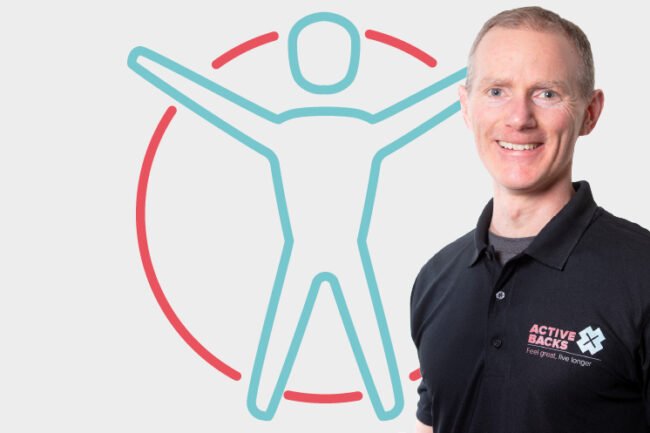How to stand with back pain / sciatica
How to stand with back pain / sciatica
This episode is entitled “How to stand with back pain / sciatica”. In it you will learn:
- Why standing still can be such a challenge with back pain / sciatica
- Why forcing a stand with back pain / sciatica is a bad idea
- The power of the wobble
- Sticks aren’t just for old men

Why standing still can be such a challenge with lower back pain / sciatica
When you stand still you are exerting a load on your lower back. The weight of your head, neck, trunk and upper limbs is pressing down on your lower back. If you’re staying in that position, trying to stand still, that’s a sustained load, and it can be a problem. Whether you have a muscle strain, disc injury or ligament strain, staying in one position exerts a constant load, and your back is already struggling. If you have a disc related sciatica, that disc is a load bearing structure. If you are maintaining a constant load on an already fatigued structure, it’s likely to start to hurt more. Remember that golden rule: “use it, but don’t abuse it”. If you do something that increases the pain, you are not going to get better. Use these different structures, but not in a way that is actively painful.
Why forcing a stand with back pain / sciatica is a bad idea
Many people say to me “oh, I’m all squint, I’m all off to one side, I need to stand up straight”. They’re forcing their body to try and get into the upright position. That might be the stooped forward. It might be, they’re all kinked off to one side, but whatever out of center alignment you are in, trying to force your body to get back into the upright position is not a good idea, particularly if it causes you more pain. So if you can stand in whatever position without pain, that’s better than standing in a bolt upright, in a fully aligned position that is painful. Don’t get into positions that increase your pain. Forcing it is a bad idea because it increases the pain, potentially prevents healing and certainly aggravates your problem.
The power of the wobble
Standing upright, or at least as close to upright as your pain will allow, and then, hopefully with feet about shoulder-width apart, very gently sway your hips from side to side. This should be a nice, relaxed, easy motion, not a rigid push. Take nice, easy breaths. Don’t look for the pain, it’s going to be there anyway. Make nice, easy and unthreatening movements. This could be a micromovement. Your hips may only be moving 5 millimeters, 5 centimeters, or 2 or 3 inches from side to side. They could even be moving as much as 6 inches.
You might find it easier to swing your hips to one side than to the other. It’s fine, the important thing is that you’re doing a nice fluid non-threatening movement that relaxes your lower back pain / sciatica. Movement is absolutely crucial. Motion is lotion. Don’t feel you have to stand still. Maybe if you’re standing, waiting for the bus in the morning, you’ll get other people joining in with your little swinging action.
Sticks aren’t just for old men
It’s better to walk with a walking stick than not walk at all, as it keeps you mobile and part of the conversation. You’re still engaged, active in day-to-day living, and not lying flat in your back doing lying down exercises. A stick may facilitate you being able to get in and out to the office, or just pottering around the house. If you have back pain / sciatica, use a stick to help you get around, but, as you improve, discard it or just use it slightly less each day.


